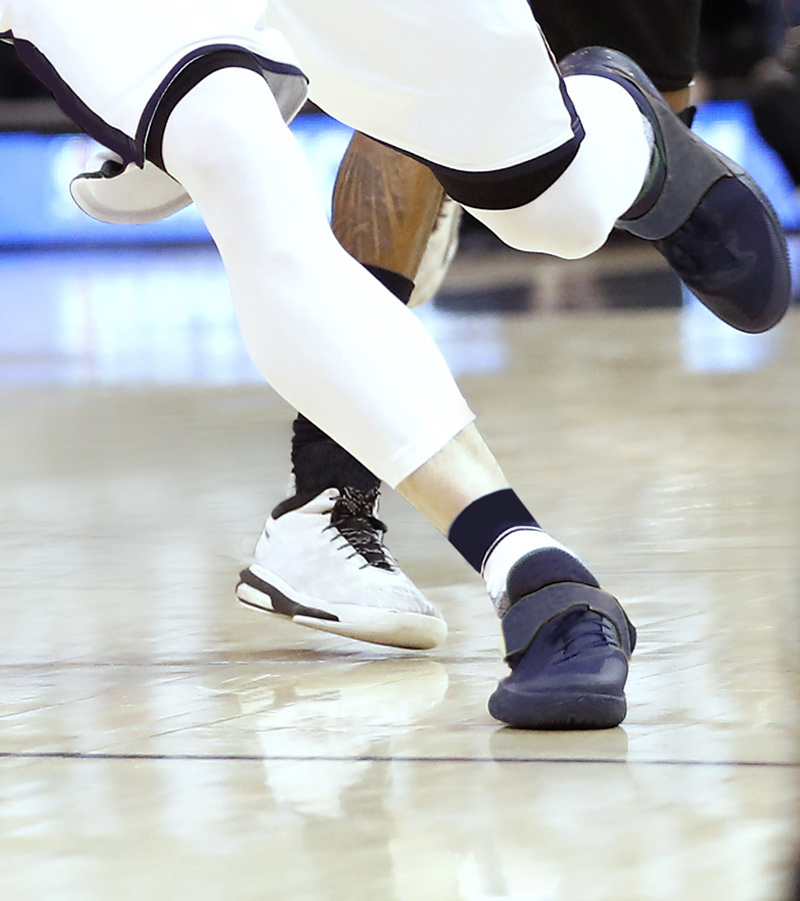
Il nostro Know How
Metodo Riva & Ricerca Scientifica
Riva Method
D. Riva e il suo gruppo di ricerca per oltre 20 anni hanno studiato l’interazione tra il piede e il suolo, e tra l’uomo e la gravità,
scoprendo che la stabilità dell’appoggio monopodalico basata sul controllo propriocettivo è indicativa della sicurezza e dell’efficacia dei movimenti umani.
Basandosi su questi principi, hanno sviluppato un sistema e una metodologia (Metodo Riva) che sblocca le potenzialità dell’allenamento propriocettivo.

La nostra Ricerca Scientifica
ARTICOLO SCIENTIFICO
Riva, D, Bianchi, R, Rocca, F, Mamo, C. Proprioceptive training and injury prevention in a professional men’s basketball team: a six-year prospective study. J Strength Cond Res 30(2): 461-475, 2016.
ABSTRACT. Single limb stance instability is a risk factor for lower extremity injuries. Therefore, the development of proprioception may play an important role in injury prevention. This investigation considered a professional basketball team for 6 years, integrating systematic proprioceptive activity in the training routine. The purpose was to assess the effectiveness of proprioceptive training programs based on quantifiable instability, to reduce ankle sprains, knee sprains, and low back pain through developing refined and long-lasting proprioceptive control. Fifty-five subjects were studied. In the first biennium (2004–2006), the preventive program consisted of classic proprioceptive exercises. In the second biennium (2006–2008), the proprioceptive training became quantifiable and interactive by means of electronic proprioceptive stations. In the third biennium (2008–2010), the intensity and the training volume increased while the session duration became shorter. Analysis of variance was used to analyze the differences in proprioceptive control between groups, years, and bienniums. Injury rates and rate ratios of injury during practices and games were estimated. The results showed a statistically significant reduction in the occurrence of ankle sprains by 81% from the first to the third biennium (p, 0.001). Low back pain showed similar results with a reduction of 77.8% (p, 0.005). The reduction in knee sprains was 64.5% (not significant). Comparing the third biennium with the level of all new entry players, proprioceptive control improved significantly by 72.2% (p, 0.001). These findings indicate that improvements in proprioceptive control in single stance may be a key factor for an effective reduction in ankle sprains, knee sprains, and low back pain.
ARTICOLO SCIENTIFICO
Riva, D, Mamo, C, Fanì, M, Saccavino, P, Rocca, F, Momenté, M, and Fratta, M. Single stance stability and proprioceptive control in older adults living at home: Gender and age differences. J Aging Res 2013: 561695, 2013.
ABSTRACT. In developed countries, falls in older people represent a rising problem. As effective prevention should start before the risk becomes evident, an early predictor is needed. Single stance instability would appear as a major risk factor. Aims of the study were to describe single stance stability, its sensory components, and their correlation with age and gender. A random sample of 597 older adults (319 men, 278 women) living at home, aged 65–84, was studied. Stability tests were performed with an electronic postural station. The single stance test showed the impairment of single stance stability in older individuals (75–84 yrs).The significant decline of stability in the older subjects may be explained by the impairment of proprioceptive control together with the decrease in compensatory visual stabilization and emergency responses. Younger subjects (65–74 yrs) exhibited better, but still inadequate, proprioceptive control with compensatory visual stabilization. Gender differences appeared in older subjects: women were significantly less stable than men. The measurement of the sensory components of single stance stability could aid in the early detection of a decay in antigravity movements many years before the risk of falling becomes evident. Adequate proprioceptive control could mitigate the effects of all other risks of falling.
ARTICOLO SCIENTIFICO
Schiavi, A, Germak, A, Mazzoleni, F, and Riva, D. Metrological characterization of rocking boards and postural readers to assess single stance stability in human subjects. In: Proceedings of the 3rd Conference on Vibration Measurement, Cape Town, South Africa, 2014.
The study of posture and movement control in humans requires technological supports able to provide accurate, reproducible and repeatable information on displacement and/or position in real-time.
A methodology used in rehabilitation and in sports medicine involves the use of rocking boards on which the subjects must keep their balance, in different operating conditions. The use of rocking boards combined with displacement and position sensors allocated at specific points of the human body, can provide information on single stance stability and contribute to reprogramming the postural and proprioceptive control of healthy and pathological subjects (orthopedic and neurological patients), mitigating the risk of falling in older subjects and decreasing the risk of injuries in sport athletes.
This paper describes the procedure used for the characterization of rocking boards (uniaxial and triaxial) and wearable sensors as postural readers, in terms of angular position. In the first step both measuring systems are characterized by a reference accelerometer, in order to accurately determine the angular positions.
A metrological approach in biomechanical measurements is necessary since it provides more accurate and reproducible data on which evaluations related to human health and wellbeing can be achieved.
ARTICOLO SCIENTIFICO
Riva, D, Rossitto, F, and Battocchio, L. Postural muscle atrophy prevention and recovery and bone remodeling through high-frequency proprioception for astronauts. Acta Astronaut 65: 813–819, 2009.
The difficulty in applying active exercises during space flights increases the importance of passive countermeasures, but coupling load and instability remains indispensable for generating high frequency (HF) proprioceptive flows and preventing muscle atrophy and osteoporosis. The present study, in microgravity conditions during a parabolic flight, verified whether an electronic system, composed of a rocking board, a postural reader and a bungee-cord loading apparatus creates HF postural instability comparable to that reachable on the Earth. Tracking the subject, in single stance, to real-time visual signals is necessary to obtain HF instability situations. The bungee-cord loading apparatus allowed the subject to manage the 81.5% body weight load (100% could easily be exceeded). A preliminary training program schedule on the Earth and in space is suggested. Comparison with a pathological muscle atrophy is presented. The possibility of generating HF proprioceptive flows could complement current countermeasures for the prevention and recovery of muscle atrophy and osteoporosis in terrestrial and space environments. These exercises combine massive activation of spindles and joint receptors, applying simultaneously HF variations of pressure to different areas of the sole of the foot. This class of exercises could improve the effectiveness of current countermeasures, reducing working time and fatigue.
ARTICOLO SCIENTIFICO
Riva, D, Trevisson, P, Minoletti, R, Riccio, MC. Sports influence on dynamic postural control during human growth. Conference: IX INTERNATIONAL CONGRESS ON AUXOLOGY Conception to maturity TORINO, 2000, Volume: Human growth from conception to maturity. Edited by G. Gilli, L.M. Schell, L. Benso. London, Smith-Gordon, 2002.
ABSTRACT. The hypokinesis that characterizes the western population can lead, also without joint injuries, to the impairment of postural control. This study investigated if different kind of sports and sedentary life can influence dynamic postural control in children. MATERIAL AND METHODS. 109 children, aged 9 to 13, were assessed to quantify dynamic postural control in single stance, with a new instrument (Delos Postural System), consisting of a rocking platform with visual feedback and a postural controller, able to discover the postural strategies. Children performed six trials of 30 seconds for each leg. RESULTS. The results showed highly significant differences (p < 0.001) in dynamic postural strategies between sports children and sedentary children. As concern different kind of sports, the groups of Gymnasts and Ice skaters (daily training) revealed significant differences (p < 0.05) in postural control with respect to the groups of Skiers and Football players (two-day week training). DISCUSSION. These results indicated that competitive sports improve dynamic postural control in children, while sedentary life does not allow to develop it at an adequate level. Sports children had a higher autonomy and privileged “visual-proprioceptive” strategies (refined), sedentary children privileged “vestibular” strategies (clumsy).



